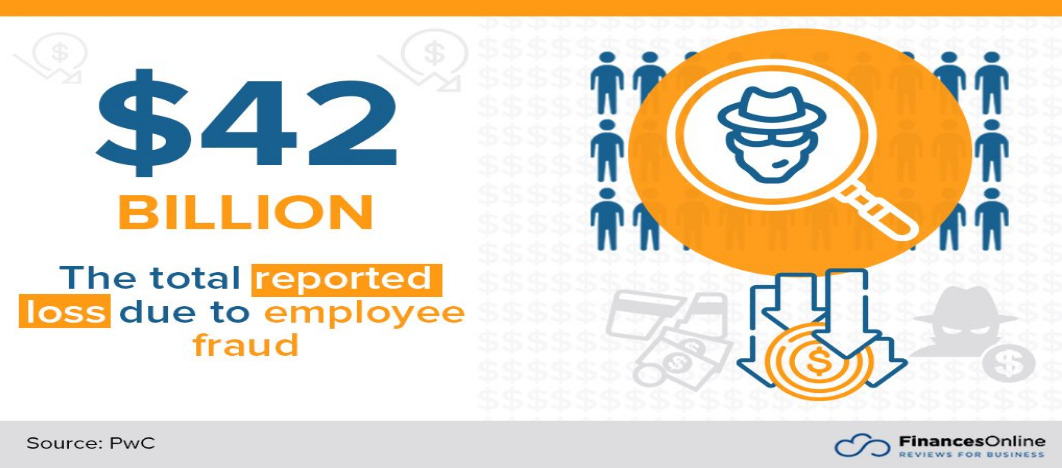Trust is an extremely important element for every business. Without confidence in your colleagues, you’ll fail to work effectively as a team, and your organization will be less productive. But trust also needs to be well placed; what if there are certain team members that aren’t trustworthy?
An unfortunate fact is that, occasionally, some employees will act in self-interest in ways that can damage a business. One of the most troublesome examples is employee fraud. Sadly, this is an issue that occurs in organizations around the world. Unfortunately, it can even be carried out by previously trusted and well-liked employees.
Left unchecked, fraud can derail a business. Instead of improving customer lifetime value SaaS, an organization is forced to focus on internal issues.
But what is employee fraud, and what can be done to prevent it? We’ll explore that and more below.
What Is Employee Fraud?

Your staff should know the ins and outs of your systems to properly provide a strong service for your business. But this also reveals a potential problem. Some staff may use their knowledge to steal or deceive their employer; this is known as employee fraud.
It should be understood that serious employee fraud is committed by a very small number of workers. But this does not make it any less problematic. Properly categorizing “serious employee fraud” is difficult. Many employees have (often unintentionally) committed some form of fraud.
For example, taking office printer paper home may be classed in some employees’ eyes as employee fraud. In fact, 75% of employees have stolen from their employer at least once. Although most organizations will choose not to crack down on minor offenses, being able to identify more serious cases is critical.
Greater oversight has helped to reduce the number of fraud-related occurrences. For example, cloud call center solutions have helped to ensure greater interconnectively. This means that employees can identify any wrong doing more quickly. Yet, despite this, fraud remains a problem.
Understanding the Different Types of Employee Fraud
When asking “What is employee fraud?”, it’s important to remember that not all instances of fraud can be viewed under one banner. There are actually six different ways of categorizing fraud. Let’s explore each example below.
Payment Fraud
As the name suggests, payment fraud describes an employee making an unauthorized payment transaction. It occurs when an employee creates a false payment or diverts a genuine one. For example, an employee could create a payment to a bogus company. Or it could involve altering the details of payees on cheques and cashing them.
Payment fraud is extremely dangerous for a business. Without proper monitoring, you could find your organization losing large amounts of cash.
Procurement Fraud
Procurement fraud refers to a wide range of illegal activities that are carried out when a business purchases goods or services. They could occur during the bidding for an item or after procurement in the form of false invoicing.
Procurement fraud is most problematic for larger organizations. Small businesses typically have fewer employees. This means that there’s more communication between team members, and any wrongdoing is easier to spot.
Travel Fraud
There may be occasions when your employees need to travel for work purposes. During these times, they can claim expenses to cover travel costs. Travel fraud is when an employee claims for journeys that haven’t been made.
It’s important to note that, like other forms of fraud, travel fraud is not always carried out intentionally. For instance, an employee might claim too much due to incorrect math.
Personnel Management Fraud
Personnel management fraud occurs when staff lies about their working patterns or levels of experience. One instance would be an employee claiming sick leave, but actually working for a different employer. Another example would be an applicant falsifying experience and qualifications to get a job.
Asset Fraud

As we’ve mentioned, your employees will have large amounts of knowledge about the inner workings of your business. This information could be exploited for personal gain. An employee could commit asset fraud by leaking private information to criminals or competitors.
Receipt Fraud
This is a dangerous (and common) form of fraud. Receipt fraud usually includes a staff member altering payment records for their own gain.
Tips for Avoiding Employee Fraud
Every organization should prioritize the identification of employee fraud. But where is the best place to start? Let’s explore some ways you can avoid fraud.
Be Alert from the Beginning
The best way to avoid fraud is by employing people that are trustworthy. But how do you ensure that an employee is as they seem? There is no clear-cut answer to this, but there are steps that you can take to give you confidence that you are employing the right people.
To reduce the chances of fraud, you should be alert from the very beginning of the hiring process. The following methods should set you on the right path.
Learn All You Can About an Applicant

The more that you can learn about an applicant, the higher the chances that they’re credible and trustworthy. One of the most significant areas that should be vetted is whether a candidate has a clean criminal record. Obviously, if a potential employee has a previous record of fraud, it isn’t a good indication of their trustworthiness.
If an applicant makes a claim, make sure that they back it up with documentation. One example is if a candidate claims to have certain qualifications. To ensure that this is true, ensure that they provide evidence of relevant certificates and awards.
Check a Candidate’s Credit History
Candidates that are struggling financially, or have a poor credit record, are usually more likely to commit a fraud offense. If you’re hiring to fill a position that involves dealing with money, it’s a good idea to first view an applicant’s credit history. If a candidate has a poor history, it’s generally advised that you don’t hire them.
Call Former Employers and Referees
An applicant might have a gleaming CV filled with experience and an impressive selection of referees, but is it trustworthy? The best way to verify a candidate’s claims is by ringing their reported former employer or contacting referees.
Once a former employee has confirmed that a candidate did, in fact, work for them, ask a simple question, namely, “Were they a trustworthy employee?”. By getting the facts straight, you can have more confidence in your hiring process.
Have a Code of Conduct in Place
A code of conduct helps to ensure that all employees know what’s acceptable. There are many reasons for a business to create a code of conduct. As well as setting out employee behavior guidelines, you can outline your financial rules. This removes any ambiguity and answers the question, “What is fraud?”.
Make sure that all new employees are introduced to your code as soon as they sign. It’s also a good idea to remind existing workers to read your policies occasionally. Ensure that staff knows to report any breaches of the code of conduct. Promoting problem based learning may help staff to identify issues more quickly.
A code of conduct is important because, if fraud does occur, you can easily point to the rules that an employee has violated.
Train Where Necessary

Training can be an excellent way of making staff aware of the danger of fraud. It also enforces the importance of employees reporting wrongdoing if they spot it.
Of course, forms of fraud will likely vary from department to department. Make sure that each team is aware of the fraud that could occur. For example, make sure that contact center coaching explains the danger of fraud related to the use of customer contact details.
Segregate Duties
In many businesses, important tasks such as payroll management is managed by a single individual. This massively increases the risk of fraud, placing confidence in a single employee. Segregation of duties splits one task into multiple roles, ensuring more oversight on important tasks.
For example, with payroll management, one employee might manage account set up, while another might deal with reconciliation. To measure the success of your segregation, you should use test execution metrics.
Of course, this sort of procedure also takes resources as it involves allocating a simple task to multiple employees. For this reason, you should only segregate duties for the most financially sensitive tasks.
Automate Some Processes
When dealing with employees, there’s always a risk, no matter how small, of fraud. With AI, there’s no risk of fraud. Using AI is also cheaper than hiring an employee. Look at your business and see if there are some areas that can be automated. For example, you could introduce an AI contact center to help deal with customer support.
Always Be Aware

Sadly, employee fraud is an ever-present danger for every business that employs staff. There’s also no way to prevent it. Instead, businesses should focus as much as possible on safeguarding against fraud. The steps outlined here help to reduce the risk of fraud. Start strategy mapping and see which options will work within your organization.
With the right protections in place, you can reduce fraud-related concerns and move your focus to growing your business.
So, put your mind at rest and start safeguarding against fraud today.
About the Author

Jenna Bunnell is the Senior Manager for Content Marketing at Dialpad, an AI-incorporated cloud based call center phone system that provides valuable call details for business owners and sales representatives. She is driven and passionate about communicating a brand’s design sensibility and visualizing how content can be presented in creative and comprehensive ways. Jenna Bunnell also published articles for domains such as Freelance Writing Gigs and Codemotion.


































